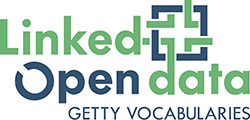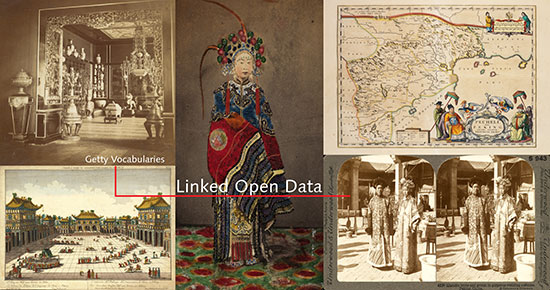Getty Vocabularies as Linked Open Data
We are launching an exciting multi-year project to update the technical infrastructure of the Getty Vocabularies. As part of this work, we are retiring some service offerings, starting with the Relational Tables and XML downloads, and the XML Web Services at the end of 2025.
A roadmap and transition plan to support the community during this change will be available in early 2025. If you use any of these services, please contact Mark Pyzyk at MPyzyk@getty.edu by January 2025 to share your use case, which will inform our transition planning.
A roadmap and transition plan to support the community during this change will be available in early 2025. If you use any of these services, please contact Mark Pyzyk at MPyzyk@getty.edu by January 2025 to share your use case, which will inform our transition planning.

|
|
Since their inception, the Getty Vocabularies have been designed to allow linking. Through LOD (Linked Open Data) releases, that goal can now be fully realized. LOD is a method of publishing datasets with semantic links that can be used by computers to aid searchers in navigating the vast universe of digital information. The Vocabularies can function as the glue joining varied and separate resources.
Through LOD, the Vocabularies can unlock and disambiguate access to many kinds of knowledge, data, and images buried in a wide variety of databases and collection management systems at museums, archives, and libraries around the world.
The documents on this page are subject to frequent modification and addition.
Through LOD, the Vocabularies can unlock and disambiguate access to many kinds of knowledge, data, and images buried in a wide variety of databases and collection management systems at museums, archives, and libraries around the world.
The documents on this page are subject to frequent modification and addition.
| |||||||||||||||||||||||||||||||||
Getty Vocabulary data in all formats are available under the Open Data Commons Attribution License (ODC-By) 1.0. AAT, TGN, and ULAN are available as LOD, XML, Relational Talbes, and APIs. CONA and IA are available through APIs. Read about the possibilities at Obtain the Getty Vocabularies.
|
| |||||||||
About Getty Vocabularies as LOD
Releasing the Getty Vocabularies as Linked Open Data is part of the Getty's ongoing effort to make its knowledge resources freely available to all. Making the Getty Vocabularies available to the research community as LOD is having a truly transformative effect on the discipline of art history in general, and on Digital Art History in particular.
Working with the community: The Getty Vocabulary team is committed to collaborating and maintaining open communication with the user community. In an ongoing effort to involve the LOD community, we have established a public discussion forum. Please use this forum to ask questions, discuss issues, and find solutions related to the technical aspects of our LOD publications. Usage examples are especially welcome and encouraged.
To join the group, send an email to gettyvocablod+subscribe@googlegroups.com.
This public discussion forum replaces previous methods of communication via email and the SemanticWeb.com Q&A forum.
For questions and comments about editorial content or general information regarding the Getty Vocabularies, please contact us at vocab@getty.edu.
Ontology update: Note that the ontology changed recently. Click on the "Developers and programmers..." link above for details.
Additional releases: In addition to LOD, the AAT, TGN, and ULAN are released periodically throughout the year in relational tables and XML formats. LOD is likely the most sustainable format over time; thus users are advised to consider transitioning to LOD if possible. Currently, CONA and IA are available as XML through APIs. All Vocabularies are available in an online Search interface.
URIs (Uniform Resource Identifiers): A description of the full set of URIs for the Getty Vocabularies is available in Getty Vocabulary Semantic Representation, section 1.5.3 GVP URLs and Prefixes.
Below please find examples of URIs to individual Vocabulary subject IDs as Semantic RDF concepts and in human-readable records. All URIs are based on the unique, persistent subject_ID of the Vocabularies.
AAT: rhyta
Human-readable full record: http://vocab.getty.edu/page/aat/300198841
Human-readable hierarchy view: http://vocab.getty.edu/hier/aat/300198841
Semantic RDF concept: http://vocab.getty.edu/aat/300198841
TGN: Siena
Human-readable full record: http://vocab.getty.edu/page/tgn/7011179
Human-readable hierarchy view: http://vocab.getty.edu/hier/tgn/7011179
Semantic RDF concept: http://vocab.getty.edu/tgn/7011179
Semantic RDF geographical info: http://vocab.getty.edu/tgn/7011179-place
ULAN: Albrecht Dürer
Human-readable full record: http://vocab.getty.edu/page/ulan/500115493
Human-readable hierarchy view: http://vocab.getty.edu/hier/ulan/500115493
Semantic RDF concept: http://vocab.getty.edu/ulan/500115493
Semantic RDF biographical info: http://vocab.getty.edu/ulan/500115493-agent
CONA: Pantheon
Human-readable full record: http://vocab.getty.edu/page/cona/700000158
Human-readable hierarchy view: http://vocab.getty.edu/hier/cona/700000158
Semantic RDF concept not available.
IA: Reclining Buddha
Human-readable full record: http://vocab.getty.edu/page/ia/1001080
Human-readable hierarchy view: http://vocab.getty.edu/hier/ia/700000158
Semantic RDF concept not available.
Why LOD?
Data about art, architecture, and other cultural heritage objects are increasingly being made available as Linked Open Data (LOD): the metadata about the objects, their creators, patrons, associated places, style, work type, iconography, and other terminology concerning their description, history, scholarly research, and conservation may be available as LOD.
When data is linked and open, it means that data is structured and published according to the principles of Linked Data, so that it can be both interlinked and made openly accessible and shareable on the Semantic Web. LOD may allow data from different resources to be interconnected and queried, thus making it more useful for serious research and discovery. Although the idea of linking data in an open way is not new, the widespread practice of doing so is relatively new, thus the protocols, standards, and licensing options used for linked open data are still evolving.
Data about art, architecture, and other cultural heritage objects are increasingly being made available as Linked Open Data (LOD): the metadata about the objects, their creators, patrons, associated places, style, work type, iconography, and other terminology concerning their description, history, scholarly research, and conservation may be available as LOD.
When data is linked and open, it means that data is structured and published according to the principles of Linked Data, so that it can be both interlinked and made openly accessible and shareable on the Semantic Web. LOD may allow data from different resources to be interconnected and queried, thus making it more useful for serious research and discovery. Although the idea of linking data in an open way is not new, the widespread practice of doing so is relatively new, thus the protocols, standards, and licensing options used for linked open data are still evolving.

|
|
In order for data to be understood and processed automatically by computers, data in records or about resources must be expressed in a standard format. Each thing (for example, a museum object, a place, or a person) must be represented by a persistent identifier (known as a Uniform Resource Identifier (URI)). A Resource Description Framework (RDF) is a language or format for describing things as well as the relationships between things as simple properties and values (known as 'triples'), while things are represented using URIs. Among the most often-used formats for publishing art vocabularies are the Simple Knowledge Organization System (SKOS) and Web Ontology Language (OWL).
If data is to be open to the community for linking and discovery, traditional licensing and copyright practices for images, art information, and associated vocabularies and metadata must be adjusted. Data is considered open if the community is free to use, reuse, and redistribute the data, subject either to no restriction or to only the requirements of attribution or share-alike. Among the licenses most often applied to art information are Open Data Commons and Creative Commons licenses, each of which offers a range of levels of openness.
If data is to be open to the community for linking and discovery, traditional licensing and copyright practices for images, art information, and associated vocabularies and metadata must be adjusted. Data is considered open if the community is free to use, reuse, and redistribute the data, subject either to no restriction or to only the requirements of attribution or share-alike. Among the licenses most often applied to art information are Open Data Commons and Creative Commons licenses, each of which offers a range of levels of openness.
The Art & Architecture Thesaurus® (AAT), the Union List of Artist Names® (ULAN), the Getty Thesaurus of Geographic Names® (TGN), the Cultural Objects Name Authority® (CONA), and the Getty Iconography Authority (IA) are copyrighted by the J. Paul Getty Trust.
Revised 11 May 2023